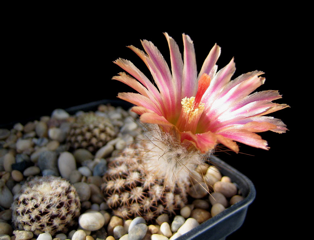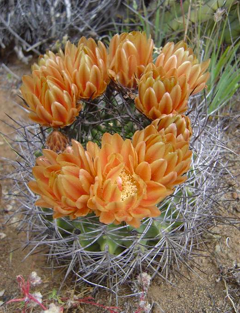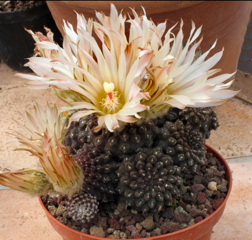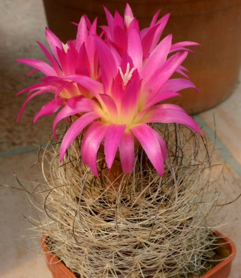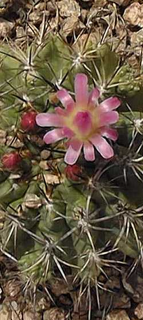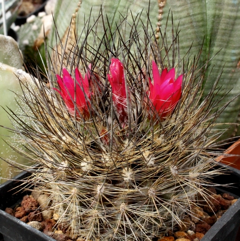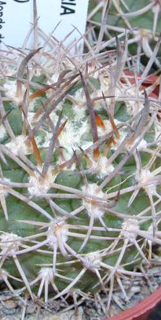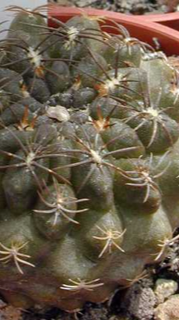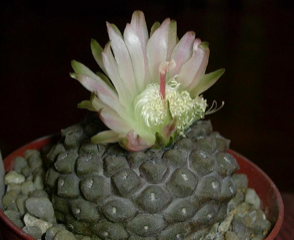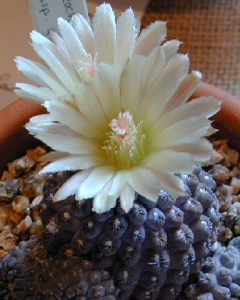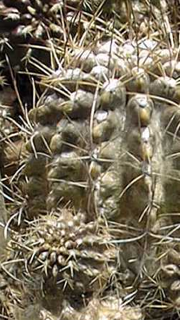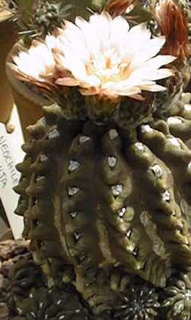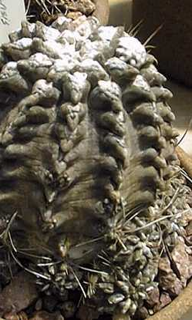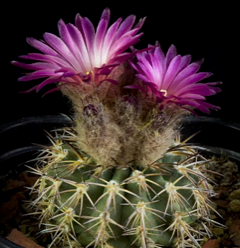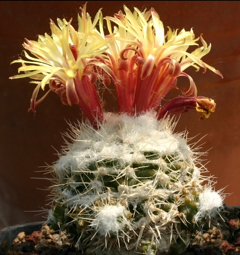Submitted by: Jim Tanner
[Ed (Mike Short): All of the cacti on this page are now in the genus Eriosyce (er-ee-oh-SY-kee). Many of you will have bought your plants under the old names of Neoporteria, Neochilenia, and Islaya. For the Mini-Show we will accept plants with those old names.]
Eriosyce is a genus of cacti native to Chile. There are both globular and columnar types that produce flowers with a spiny and hairy tube. The flowers grow laterally on specially formed areoles.
Almost all of these plants need a deep pot with very good drainage to accommodate a tap root. It is susceptible to over-watering. Occasionally some are grafted to avoid root rot problems. Keep dry in winter. Best suited for airy exposures. They like full sun; and can tolerate light shade. They like warmth (recommended minimum winter temperature: 40°F). But a plant kept perfectly dry can easily survive at winter night-time temperatures below freezing – especially if warmed to near 60 F the next day.
Some if not all are especially prone to rot, therefore, under-pot in a smaller container filled with very porous compost. Mealies can also attach themselves to the spines, plant body, and roots.
Neoporteria and Neochilenia are genera from the Central and Northern Coasts of Chile, and the Southern Coast of Peru.
This area has a Mediterranean climate, with rain in the winter, and mostly dry summers. The climate is similar to Southern California. Fogs are more frequent, and can sometimes be the predominant source of water.
The genus Neochilenia was never really distinguishable from Neoporteria, except for a greater tendency towards tuberous roots. In any case, in recent times both have been incorporated, with several other genera into the genus Eriosyce. This is becoming less controversial with time, and in most of our shows, Neoporteria and Neochilenia are now combined with Eriosyce.
Cultivation of Neoporteria is relatively easy. They will do well in pots or in the ground in Southern California, and require little or no protection from weather. One challenge in growing this genus, particularly with some of the old Neochilenia is to get growth started in the spring without cracking the body. Growing in a very open potting mix and careful watering, particularly if the plant was dry all winter, helps.
In habitat these are often solitary, but in cultivation they often clump. Propagation by removal of the offsets is an easy and reliable method of propagation. Grafted plants will quickly clump, and these heads can be removed and re-rooted. Seed for many species and localities are available from a number of suppliers, and these generally germinate well and grow strongly.
Tom Glavich
Islaya is a genus of cactus. This genus is named after a Peruvian city of the same name. It is now treated as a synonym of Eriosyce.
[Ed (Mike Short): Islaya has now been moved to the genus Eriosyce. The move may be rather confusing as it seems many of the Islaya species were simply renamed Eriosyce islayensis making it impossible to differentiate between them. Those Islaya species ‘might’ at some time in the future become a variety, cultivar, subspecies or forma of Eriosyce, as with Islaya laui which has become Eriosyce laui. Some examples that have been renamed Eriosyce islayensis are: Islaya divaricatiflora, Islaya brevicylindrica, Islaya bicolor, Islaya flavida, Islaya grandiflorens, Islaya grandis, Islaya maritima, Islaya minor, Islaya minuscula, & Islaya unguispina. Even Islaya islayensis has been renamed as Eriosyce islayensis. If you have an Islaya species it might be wise to retain the species name along with the new name Eriosyce islayensis.]
LATIN LOOKUP – Loquerisne Latine (Do you speak Latin)?
The meanings of latin plant names on this page – from http://davesgarden.com/guides/botanary/
- bicolor [BY-kul-ur]
Of two colors. - castanea [kas-TAN-nee-uh]
The Latin name for chestnut. - clavata [KLAV-ah-tuh]
Club-shaped. - crispa [KRISP-uh]
With curled or wavy margins. - Eriosyce [er-ee-oh-SY-kee]
From the Greek erion (wolly) and sykon (fig, fruit). - flavida [FLA-vid-uh, FLAY-vid-uh]
Yellowish. - grandis [GRAN-dees, GRAN-dis]
Large, spectacular. - jussieui [ZHOO-syoo-eye]
Named for Bernard, Joseph, Antoine-Laurent and Adrien-Laurent-Henri de Jussieu, a family of 18th and 19th century French botanists. - laui [LAU-eye]
Named for Dr. Alfred B. Lau, 21st century cactus collector and explorer. - maritima [muh-RIT-tim-muh, mar-ih-TEE-muh]
Of or from the sea. - minor [MY-nor]
Smaller, lesser. - minuscula [min-oo-SKYOO-luh]
Very small. - napina [na-PIN-a]
Resembles Napus (turnip genus). - occulta [ock-ULL-tuh]
Secret. - senilis [SEE-nil-is]
Of an old man. - subgibbosa [sub-gib-BOH-suh]
Having a small or slightly swollen hump. - villosa [vil-OH-suh]
Covered with soft hairs.
